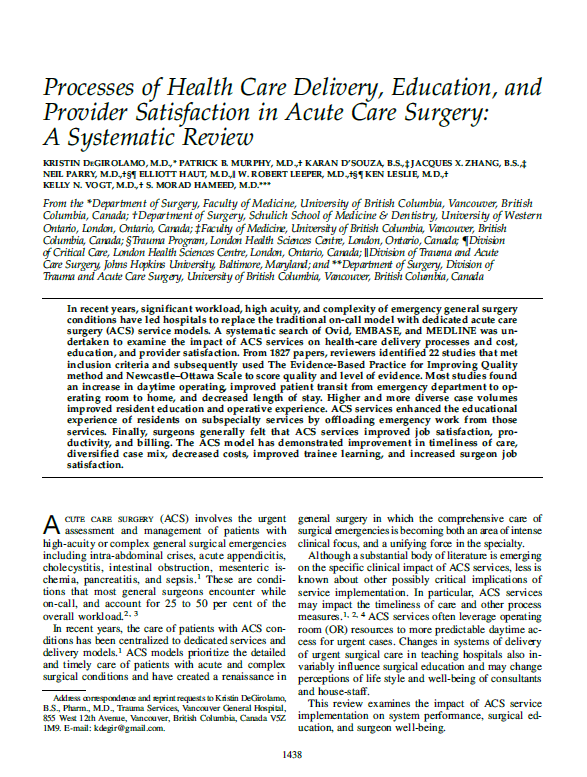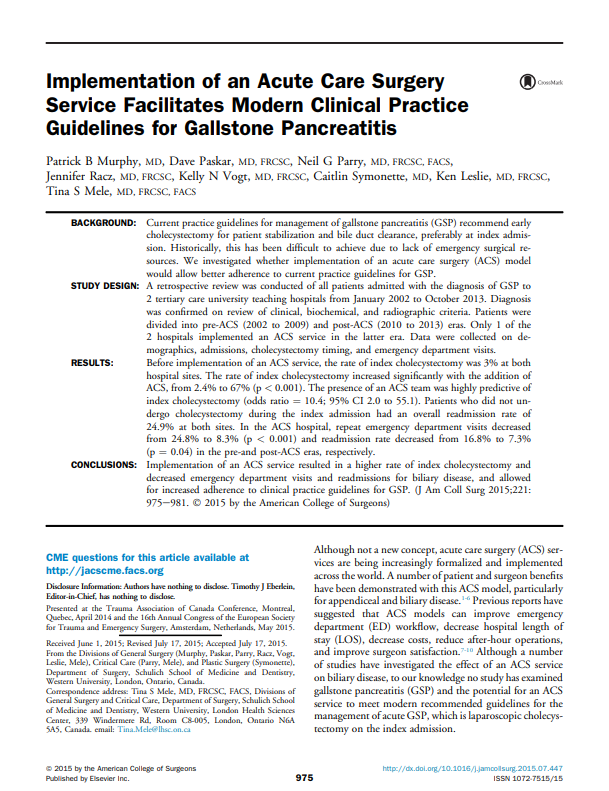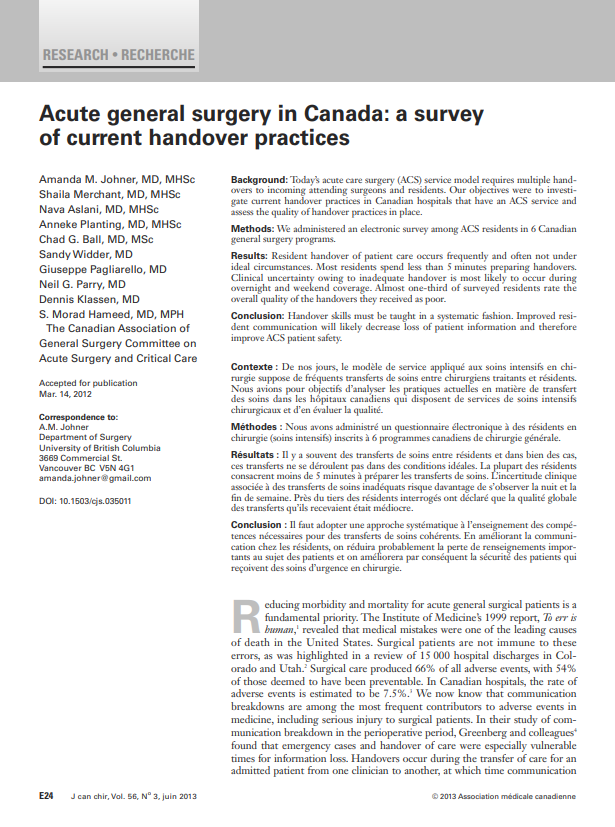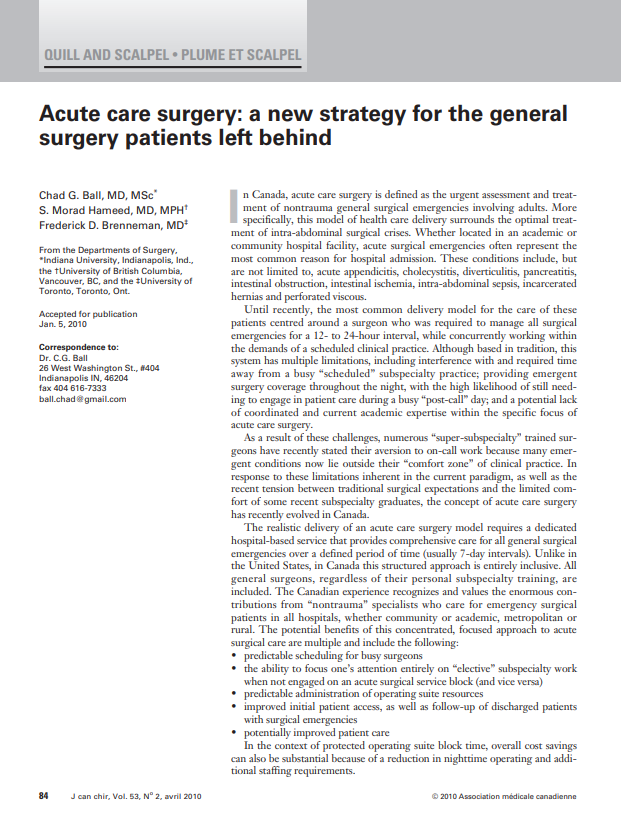Publications by CANUCS
Impact of interhospital transfer on patient outcomes in emergency general surgery
Surgery, 2020
Methods: Multi-center retrospective study on the impact of transfer on EGS outcomes.
Conclusions: Transferred EGS patients have worse outcomes compared to patients directly admitted
Patterns of complex emergency general surgery in Canada
Canadian Journal of Surgery, 2020
Methods: Multi-center retrospective study on the epidemiology of complex EGS in Canada
Conclusions: Large volume of non-appendiceal, non-biliary EGS performed in Canada with a substantial risk of morbitity and mortality
A 30-day prospective audit of all inpatient complications following acute care surgery: How well do we really perform?
Canadian Journal of Surgery, 2020
Methods: Prospective, multi-center study of all patients undergoing operating intervention for an emergency general surgery condition
Conclusions: Overall morbidity was 34% and mortality was 2%. Intensive care admission was required for 6% of patients undergoing an operation
Publications by CANUCS Members
The emergence of the physician assistant role in a Canadian acute care surgery setting
Canadian Journal of Surgery, 2020
Methods: Single-center retrospective study on the impact of a PA on efficiency of ACS service
Conclusions: Physician assistants are a valuable resource for a busy ACS service. They provide consistency and address workforce strains with decreasing resident numbers.
Operative timing is associated with increased morbidity and mortality in patients undergoing emergency general surgery: a multisite study of emergency general services in a single academic network
Canadian Journal of Surgery, 2020
Methods: Multi-center retrospective study within a single academic network on the impact of operative timing on EGS outcomes
Conclusions: Overnight operating and delays to operation were associated with increased odds of morbidity and mortality
Cause for concern: Resident experience in operative trauma during general surgery residency at a Canadian center
Canadian Medical Education Journal, 2020
Methods: Single center retrospective study investigating resident exposure to operative trauma over 10 years
Conclusions: Operative trauma exposure was rare and inadequate compared to USA counter-parts
Venous thromboembolism in emergency general surgery patients: a single-center retrospective cohort study
Canadian Journal of Surgery, 2020
Methods: Single-center retrospective study on the rates of VTE in operative EGS
Conclusions: After operative EGS 2.3% of patients experienced an in-hospital VTE and 1.6% were diagnosed with a VTE following discharge. Only 66% of patients recieved appropriate VTE prophylaxis.
A day in the life of emergency general surgery in Canada: a multicenter observational study
Canadian Journal of Surgery, 2018
Methods: Multi-center cross-sectional study of EGS services at 14 hospitals across Canada.
Conclusions: The patient mix was variable and complex, the average number of co-morbidities per patient was 3. Only 50% of patients on an EGS require an operation. The most common pathologies were gallbladder (18%), obstruction (15%), and appendiceal (8%)
Beyond just the operating room: characterizing the complete caseload of a tertiary acute care surgery service
Canadian Journal of Surgery, 2018
Methods: Single center, prospective cohort study on the case-mix of a tertiary care ACS service
Conclusions: Bowel obstruction (21%) was the most common reason for admission to the ACS service. Only 50% of patients were operative and only 20% of in-patient consults were operative. 30-day readmission was 17% and mortality was 1.7%.
Acute care surgery: a means for providing cost-effective, quality care for gallstone pancreatitis
World Journal of Emergency Surgery, 2017
Methods: Multi-center, retrospective cohort study on the impact of ACS on cost and quality of life for gallstone pancreatitis
Conclusions: Implementation of ACS service was associated with decreased cost ($1162/patient) and increased quality-adjusted life year ratio
Impact of the acute care surgery model on disease- and patient-specific outcomes in appendicitis and biliary disease: A meta-analysis
Journal of the American College of Surgeons, 2017
Methods: Meta-analysis on the impact of ACS services on timely access to care, length of stay and morbidity/mortality
Conclusions: Implementation of ACS service was associated a reduced length of stay and fewer complications for biliary and appendiceal disease.
Processes of health care delivery, education, and provider satisfaction in acute care surgery: a systematic review
American Surgeon, 2017
Methods: Systematic review on the impact of ACS services on delivery of healthcare, resident education and surgeon satisfaction
Conclusions: The benefit of an ACS service include more daytime operating, increased resident education due to a wide breadth of general surgery patients and improved provider satisfaction
Timely surgical care for acute biliary disease: An indication of quality
Annals of Surgery, 2016
Methods: Position paper discussing quality markers for acute biliary disease and design of services to achieve high-quality care
Conclusions: An index cholecystectomy rate of over 75% may be an indicator of quality of care. Dedicated acute surgical services with oeprative resources can achieve this goal.
Implementation of an acute care surgery service facilitates modern clinical practice guidelines for gallstone pancreatitis
Journal of the American College of Surgeons, 2015
Methods: Single-center, retrospective cohort study on the rate of index cholecystectomy for gallstone pancreatitis before and after adoption of dedicated acute care surgery services
Conclusions: Index cholecystectomy rate increased from 2% to 67% with the addition of a dedicated acute care surgery service. Repeat emergency room visits decreaed from 25% to 8% and re-admissions from 17% to 7%.
Acute general surgery in Canada: a survey of current handover practices
Canadian Journal of Surgery, 2013
Methods: Survey of ACS residents at 6 centers across Canada
Conclusions: Frequent communication errors occur during handover of ACS patients and over 1/3 of residents rated handover quality as poor. A systematic approach with dedicated and uninteruptted time is needed for safe handover of patient care.
Impact of an acute care surgery model with a dedicated operating room on outcomes and timeliness of care in patients with biliary tract disease
World Journal of Surgery, 2013
Methods: Single-center, retrospective cohort study on acute biliary disease before and after an ACS service was adopted
Conclusions: Time to operation was reduced with the addition of an ACS team with dedicated operative resources
Acute care surgery: a new strategy for the general surgery patients left behind
Canadian Journal of Surgery, 2010
Methods: Position paper discussing the design of a new model of care for emergency general surgery patients
Conclusions: The transformation from the 24-hour model of call to ‘surgeon of the week’ model with dedicated resources can improve patient continuity and outcomes.
General surgery 2.0: the emergence of acute care surgery in Canada
Canadian Journal of Surgery, 2010
Methods: The results of the Canadian Association of General Surgery Acute Care Summit in 2009
Conclusions: Most acute care surgery services in Canada began in 2007 or later. The expansion of acute care surgery model will benefit patients and providers. A unified national agenda was established.


















